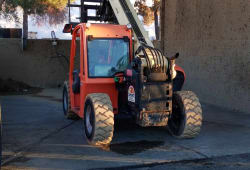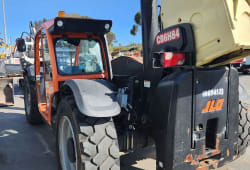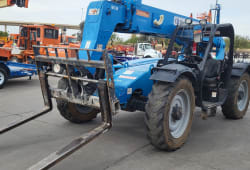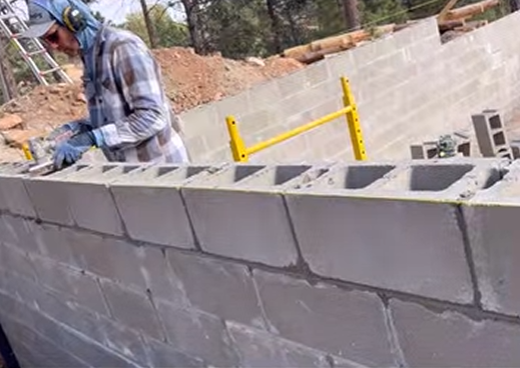Assessing Telehandler Capacity and Reach for Your Needs
14 Min read
)
August 10, 2023
Telehandlers are versatile machines that play a crucial role in various construction, agriculture, and industrial projects. These machines combine the functionalities of a forklift and a crane, making them invaluable for lifting, transporting, and manipulating heavy loads. To ensure optimum performance and efficiency, it is essential to understand how to determine the telehandler capacity and reach that will best meet your specific needs.
Understanding Telehandler Basics
Before delving into the specifics of determining telehandler capacity and reach, it is important to have a solid understanding of what a telehandler is and its key components.
A telehandler, also known as a telescopic handler or a telehandler forklift, is a versatile machine that features an extendable boom with a lifting attachment at the end. It is designed to lift and move loads vertically and horizontally, providing greater reach and flexibility compared to traditional forklifts.
Telehandlers are commonly used in construction, agriculture, and industrial settings due to their ability to handle a wide range of tasks. They can lift heavy loads, transport materials across uneven terrain, and reach heights that would otherwise be difficult to access.
Key Components of a Telehandler
A telehandler typically consists of several key components that work together to enable its lifting and maneuvering capabilities. These components include the chassis, boom, lifting attachment, hydraulic system, and controls. Each component plays a critical role in the overall performance and function of the telehandler.
The chassis is the main framework of the telehandler and provides stability and support. It is designed to withstand heavy loads and rough terrain, ensuring the machine remains balanced and secure during operation.
The boom is the extendable arm of the telehandler and is responsible for lifting and reaching. It can be adjusted to various lengths, allowing the telehandler to reach different heights and distances. The boom is typically made of high-strength steel to ensure durability and stability.
The lifting attachment is the tool or device that is attached to the end of the boom and is used to lift and carry loads. Common lifting attachments include forks, buckets, and platforms. The type of attachment used depends on the specific task and the type of material being handled.
The hydraulic system is the power source of the telehandler and is responsible for operating the boom and lifting attachment. It uses hydraulic fluid and pressure to control the movement and functions of the machine. The hydraulic system is controlled by a series of valves and levers, allowing the operator to manipulate the telehandler with precision.
The controls of a telehandler are located in the operator's cabin or on a control panel and allow the operator to control the movement and functions of the machine. The controls typically include joysticks, buttons, and switches that are used to operate the boom, lifting attachment, and other functions of the telehandler.
Understanding the key components of a telehandler is essential for safe and efficient operation. By knowing how each component works and interacts with the others, operators can maximize the capabilities of the machine and ensure that it is used in a way that is safe for both the operator and those around them.
Assessing Your Project Needs
Before selecting a telehandler with the appropriate capacity and reach, it is necessary to assess your project needs. This involves evaluating your site conditions and identifying the specific load requirements.
Evaluating Your Site Conditions
Site conditions can greatly impact the performance and maneuverability of a telehandler. Consider factors such as terrain type, ground stability, space restrictions, and overhead obstructions. These factors will help determine the type and size of telehandler best suited for your project.
Firstly, let's talk about terrain type. Is your project located on a flat surface or does it involve uneven terrain? If your site has rough or uneven ground, you will need a telehandler with excellent off-road capabilities and stability to ensure safe operation.
Ground stability is another crucial factor to consider. If your project is situated on unstable ground, such as loose soil or muddy conditions, it is important to select a telehandler with a wider base and robust tires for enhanced stability and traction.
Space restrictions are also an important consideration. If your project site has limited space, you will need a telehandler with compact dimensions and excellent maneuverability. This will allow you to navigate through tight spaces and work efficiently without any hindrances.
Furthermore, overhead obstructions can pose a challenge when operating a telehandler. If your project site has low-hanging structures or obstacles, it is essential to choose a telehandler with a suitable height and reach capacity to ensure safe clearance and prevent any accidents.
Identifying Your Load Requirements
Understanding the weight and size of the loads you will be lifting is crucial in determining the required telehandler capacity. Consider the maximum load weight and the maximum height or reach at which the loads will be handled. This information will enable you to select a telehandler that can safely and effectively handle your specific load requirements.
When assessing load requirements, it is important to consider the maximum load weight. Different telehandlers have varying weight capacities, and exceeding the specified limit can lead to instability and potential accidents. By accurately determining the maximum load weight, you can select a telehandler that can handle the load safely and efficiently.
In addition to weight, the maximum height or reach at which the loads will be handled is another crucial factor. If your project requires lifting loads to significant heights or reaching out to distant areas, you will need a telehandler with an appropriate boom length and reach capacity. This will ensure that the telehandler can effectively reach the desired height and distance without compromising safety.
By thoroughly evaluating your site conditions and identifying your load requirements, you can make an informed decision when selecting a telehandler. Taking these factors into account will not only enhance the efficiency and productivity of your project but also prioritize the safety of your workers and equipment.
Understanding Telehandler Capacity
Telehandler capacity refers to the maximum weight a telehandler can safely lift and operate with. Understanding telehandler capacity is essential to prevent accidents, avoid equipment damage, and ensure the efficiency of your operations.
When it comes to telehandler capacity, there are several key factors to consider. These factors include boom extension, boom angle, load position, and stability. Each of these elements plays a crucial role in determining the overall capacity of the telehandler.
How is Telehandler Capacity Measured?
Telehandler capacity is expressed in terms of maximum lifting capacity and maximum reach at a specific load height. The lifting capacity is typically given in pounds or kilograms, while the reach is indicated by the maximum forward reach in feet or meters. Manufacturers provide these specifications for each model of telehandler they produce.
The boom extension is an important factor in telehandler capacity. By extending the boom, the telehandler can reach greater heights and lift heavier loads. However, it's crucial to ensure that the telehandler is not overloaded beyond its maximum lifting capacity.
Another factor that affects telehandler capacity is the boom angle. The angle at which the boom is positioned can impact the stability and lifting capacity of the telehandler. It's important to follow the manufacturer's guidelines and recommendations for the appropriate boom angle for different lifting tasks.
Factors Influencing Telehandler Capacity
Several factors can influence a telehandler's capacity, including boom extension, boom angle, load position, and stability. Boom extension and angle affect the leverage and stability of the telehandler, while load position determines the distribution of weight. Proper telehandler operation, taking into account these factors, is critical to prevent toppling or tipping hazards.
Load position is another crucial factor when it comes to telehandler capacity. The position of the load on the telehandler's forks can significantly impact its stability and lifting capacity. It's important to ensure that the load is evenly distributed and properly secured to prevent any accidents or damage to the telehandler.
Stability is a key consideration when operating a telehandler. The stability of the telehandler is influenced by various factors, including weight distribution, ground conditions, and the telehandler's center of gravity. Operators must be aware of these factors and take appropriate measures to maintain stability during lifting operations.
In conclusion, understanding telehandler capacity is crucial for safe and efficient operations. By considering factors such as boom extension, boom angle, load position, and stability, operators can ensure that they are operating within the telehandler's specified capacity limits. This knowledge and adherence to safety guidelines will help prevent accidents, and equipment damage, and improve overall productivity.
Exploring Telehandler Reach
In addition to capacity, telehandler reach is a vital consideration when determining the right telehandler for your needs. Reach refers to the horizontal distance a telehandler can extend its boom, allowing it to access and maneuver loads in various positions and locations.
Defining Telehandler Reach
Telehandler reach is defined by the maximum distance from the front wheels or the chassis to the load's tip. This measurement is essential for assessing whether a telehandler can reach the desired height and position for your specific project requirements.
When evaluating telehandler reach, it's important to consider not only the maximum reach but also the reach at different heights. Some telehandlers may have a longer reach at lower heights, while others may excel in reaching higher elevations. Understanding these specifications will help you choose the telehandler that best suits your project's needs.
Furthermore, it's worth noting that telehandler reach is often influenced by other factors, such as the weight of the load and the angle at which the boom is extended. These variables can affect the telehandler's ability to reach its maximum capacity, so it's crucial to factor them into your decision-making process.
The Importance of Reach in Your Operations
Choosing a telehandler with the appropriate reach is crucial for maximizing productivity and efficiency in your operations. Insufficient reach may require additional maneuvers or repositioning, slowing down work and potentially compromising safety. Imagine a scenario where you need to lift materials to a specific height on a construction site. If the telehandler you choose doesn't have enough reach, you may have to spend extra time repositioning the machine or even bringing in additional equipment, causing unnecessary delays and added costs.
On the other hand, selecting a telehandler with excessive reach can be less economical and may limit maneuverability in confined spaces. Consider a warehouse setting where space is limited, and you need to maneuver the telehandler in narrow aisles. Opting for a telehandler with excessive reach may hinder your ability to navigate efficiently, resulting in potential damage to the surroundings or even accidents.
Moreover, the importance of reach extends beyond the operational aspects. It also plays a significant role in ensuring the safety of your workers. By choosing a telehandler with the appropriate reach, you can minimize the need for operators to stretch or lean dangerously to access loads, reducing the risk of accidents and injuries on the job site.
Ultimately, finding the right telehandler with optimal reach requires careful consideration of your project's specific requirements, including the height and position of the loads you regularly handle. By taking the time to assess these factors and selecting a telehandler that meets your needs, you can enhance productivity, improve safety, and streamline your operations.
Matching Telehandler Capacity and Reach to Your Needs
Now that you have a solid understanding of telehandler capacity and reach, it is time to match them to your specific project needs.
Considerations for Selecting the Right Telehandler
When selecting a telehandler, consider factors such as the maximum lifting capacity, maximum reach, maneuverability, and stability. These factors play a crucial role in ensuring the successful completion of your project.
The maximum lifting capacity is an important consideration as it determines the weight that the telehandler can safely lift. It is essential to evaluate your load requirements and choose a telehandler with a capacity that exceeds your needs. This ensures that you can handle any unexpected changes or additions to your project without compromising safety.
Another crucial factor to consider is the maximum reach of the telehandler. The reach determines how far the telehandler can extend its boom, allowing you to access materials or equipment at different heights and distances. It is important to assess the height and reach requirements of your project and select a telehandler that can meet or exceed those specifications.
Maneuverability is also a key consideration when selecting a telehandler. The ability to navigate through tight spaces or uneven terrain can greatly impact the efficiency and productivity of your project. Evaluate the site conditions where the telehandler will be used and choose a model with the appropriate size and maneuverability features to ensure smooth operations.
Stability is another critical factor that should not be overlooked. A stable telehandler is essential for the safe lifting and transporting of heavy loads. Consider the terrain and ground conditions of your project site and select a telehandler with features such as stabilizers or outriggers to provide the necessary stability during operations.
Case Studies: Successful Telehandler Selection
Examining case studies of projects similar to yours can provide valuable insights into successful telehandler selection. Understanding how others have matched the telehandler's capacity and reach their needs can guide you in making informed decisions for your project.
One case study involves a construction project that required lifting heavy steel beams to construct a multi-story building. The project team carefully assessed the weight of the beams and selected a telehandler with a lifting capacity that exceeded the maximum weight. This allowed them to handle the beams safely and efficiently, without any delays or safety concerns.
In another case study, a telehandler was needed for a landscaping project that involved transporting and placing large trees. The project team considered the reach requirements for lifting the trees from the ground and placing them in the desired locations. They selected a telehandler with an extended reach, which enabled them to complete the project with precision and accuracy.
These case studies highlight the importance of matching telehandler capacity and reach to the specific needs of a project. By learning from these examples, you can make informed decisions and ensure the successful completion of your project.
Safety Considerations When Operating a Telehandler
Safety should always be a top priority when operating a telehandler. Adhering to basic safety guidelines and ensuring proper training and certification for telehandler operators are essential for preventing accidents and injuries.
Basic Safety Guidelines
Follow these basic safety guidelines when operating a telehandler:
Inspect the telehandler before each use, checking for any signs of damage or wear.
Ensure proper maintenance and servicing of the telehandler to keep it in good working condition.
Only operate the telehandler if you have received proper training and certification.
Always wear the appropriate personal protective equipment (PPE), including a hard hat and safety harness.
Do not exceed the telehandler's maximum load capacity or reach limits.
Operate the telehandler on stable and level ground, avoiding steep slopes or uneven terrain.
Be aware of your surroundings, including overhead power lines and other potential hazards.
Use caution when loading and unloading materials to prevent accidents or damage.
Follow proper signaling and communication protocols when working with other personnel.
Never leave the telehandler unattended while the engine is running.
Training and Certification for Telehandler Operators
Proper training and certification for telehandler operators are crucial for safe and efficient operations. Operators should receive comprehensive training in operating procedures, safety guidelines, and emergency protocols. Certification ensures that operators have the necessary knowledge and skills to operate a telehandler effectively.
Conclusion: Maximizing Efficiency with the Right Telehandler
By determining the telehandler capacity and reach that best meet your needs, you can maximize efficiency and productivity in your projects. Matching the telehandler to your site conditions, load requirements, and safety considerations ensure smooth operations and helps prevent accidents.
Recap of Key Points
Throughout this article, we have explored the basics of telehandlers, the process of assessing project needs, understanding telehandler capacity and reach, matching them to your specific requirements, and the importance of safety considerations. By considering these key points, you can make informed decisions in determining telehandler capacity and reach for your needs.
Future Trends in Telehandler Technology
As technology continues to evolve, telehandlers are also likely to see advancements in their capabilities and features. Keep an eye on future trends in telehandler technology, such as improved fuel efficiency, advanced safety systems, and innovative attachments, which can further enhance the efficiency and versatility of these machines.














